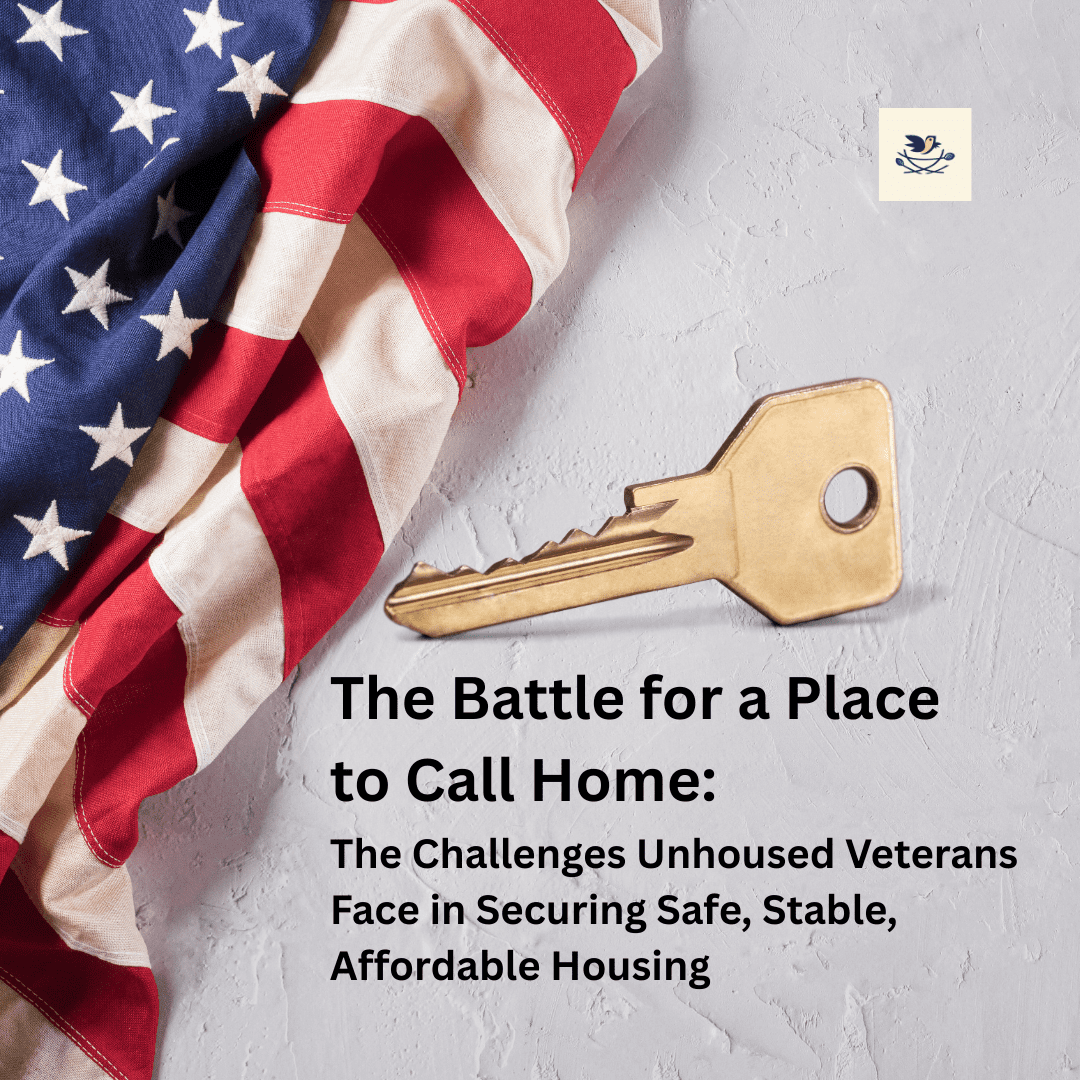
This Veterans Day, as we honor those who have served our nation, at Nest Community Shelter, we want to discuss the harsh reality for thousands of veterans who defended our country but struggle to secure safe and stable housing. This is the latest installment in our series examining the experiences of unhoused individuals and the systemic barriers they face when trying to secure housing.
Did you know that in January 2024 (the last PIT Count), there were 32,882 veterans experiencing homelessness in the United States, representing a record low since measurement began in 2009. And while we are making strides in the right direction for this population, each number represents a person who served their country and is now unhoused, with challenges and obstacles to securing stable, affordable housing.
The Affordability Crisis: When Income Can’t Keep Pace with Rent
The most fundamental barrier facing unhoused veterans is, simply put, that housing costs far exceed what they can afford in many parts of the country. About a third of veterans who served after 2001 pay more than 30% of their income on housing, according to the National Veterans Homeless Support, a nonprofit organization dedicated to serving unhoused veterans. For veterans living on fixed incomes from disability benefits or struggling in low-wage jobs, even modest rent increases can mean the difference between being housed and being unhoused.
While many believe that there is funding assistance for veterans, often this population goes unserved due to a lack of funding for housing assistance. Simply put, the help that should be there often isn’t due to underfunding.
An estimated 1.3 million, or approximately 56 percent of low-income veteran households, experienced housing insecurity directly due to the rising cost of housing. When more than 30% of one’s income is spent on housing, this puts that individual at higher risk of experiencing housing insecurity or becoming unhoused. This means that for an individual spending a large amount of their income on rent, one financial disaster, such as an illness, broken car, or job loss, can quickly spiral into becoming unhoused.
The Upfront Cost Barrier: Security Deposits and Move-In Expenses
Before a veteran can even move into affordable housing, they face a financial wall: security deposits, first and last month’s rent, application fees, and utility deposits. These costs, which can total thousands of dollars, can be out of reach for most veterans experiencing homelessness to conquer on their own.
While programs exist to help, such as Supportive Services for Veteran Families (SSVF) which provides up to one month’s rent assistance for security deposits, and the Homeless to Housing (H2H) Program offers up to $2,000 for housing-related costs, including deposits; these resources remain limited, and not all veterans know they exist. Navigating these programs while unhoused poses an entirely new set of challenges, and this is where an organization like Nest comes into play. For example, simply proving you are who you say you are in order to access these programs, an ID is required. While this may seem simple and straightforward, for those who’ve been unhoused, this can be a massive undertaking, simply obtaining an ID in order to begin the process for receiving support.
Source of Income Discrimination: When Your Voucher Isn’t Welcome
Even when veterans secure housing vouchers designed to make rent affordable, they often face another hurdle: landlord discrimination. While there is no recent number (the last count was in 2014), the last reported number of veterans utilizing the Housing Choice Voucher program (formerly known as Section 8) was 340,000 veterans to cover rent. There are no federal protections in place to prevent individuals from being denied housing solely because of their source of income. A housing voucher does not automatically mean secured housing; in many cases, it can mean the opposite.
Landlords in most states can legally refuse to rent to veterans simply because they use VA benefits or housing vouchers to pay rent. According to the National Fair Housing Alliance, in 2023, fair housing complaints increased to over 34,000, with complaints related to source of income discrimination as the largest category of discrimination. Veterans who served their country find themselves turned away from housing, not because they can’t pay, but because of how they pay.
Mental Health and PTSD: The Invisible Wounds That Become Housing Barriers
The mental health challenges many veterans face create profound barriers to obtaining and maintaining housing. The National Coalition of Homeless Veterans and the Department of Veterans Affairs estimate that between 48% to 67% of homeless veterans were diagnosed with mental health disorders. Furthermore, seven out of every 100 veterans will suffer from PTSD throughout their lives. While this does not mean that every unhoused veteran will experience these mental health issues, it is significant to mention in this article as it can present a firm barrier.
These conditions can be a leading contributor to becoming unhoused, and they make it more challenging to heal from. Navigating housing applications, maintaining appointments, and following through on complex bureaucratic processes becomes exponentially more difficult when you’re dealing with untreated PTSD or severe depression. Landlords may view symptoms of these conditions as red flags, further limiting housing options.
The Discharge Status Trap: When Service Doesn’t Equal Benefits
Not all veterans have equal access to housing programs, and discharge status creates one of the most significant divides. Veterans with other than honorable discharges make up 3 percent of the veteran population, but they compose 15 percent of the unhoused veteran population.
These veterans often received their discharge status due to issues directly related to untreated mental health conditions or substance abuse, conditions that frequently stem from their military service. Veterans with other than honorable (OTH) discharges face the loss of some veteran benefits, such as housing programs offered by the VA, and they are typically not eligible for GI Bill education benefits. They served their country, but when they needed help most, the door was closed.
Eviction History: A Permanent Mark
For veterans who have previously lost housing, that history follows them. Even a single eviction, perhaps due to a hospitalization, a mental health crisis, or temporary job loss, can make it nearly impossible to find new housing. Landlords routinely screen for eviction history, and many automatically reject any applicant with an eviction record, regardless of how long ago it occurred or the circumstances surrounding it. This means that even if a veteran has worked to rebuild their lives, saved for a deposit application fee, and is financially stable, they are often denied housing due to a previous eviction.
The VA Benefit System: Challenging to Navigate
Many veterans reported that understanding the regulations for receiving subsidized housing was difficult, and the lack of pertinent information and educational support to guide them through these programs was a significant challenge. The very system designed to help veterans can become another barrier. Complex paperwork, long wait times, confusing eligibility requirements, and the need to prove service-connection for disabilities all create obstacles that can take months or years to overcome.
For a veteran in crisis, perhaps staying in their car or couch-surfing, the patience required to navigate these systems while managing mental health challenges, job searching, and meeting basic survival needs is often impossible to sustain.
Accessibility Challenges: When Housing Doesn’t Fit Physical Needs
For veterans with service-related disabilities, finding housing presents additional challenges on top of the ones we’ve already discussed. Not only were homes with accessible accommodations difficult to find, but they often come with an extra expense and or long waitlists for occupancy.
The Compounding Effect: When One Barrier Becomes Many
These barriers don’t exist in isolation, and that is truly important to understand. A veteran might face affordable housing shortages, mental health challenges, a source of income discrimination, AND poor credit from medical bills. Each barrier makes the others more challenging to overcome. A veteran dealing with PTSD may find it more difficult to navigate the complex system of following the proper channels for support. A veteran with an eviction on their record due to a mental health crisis finds fewer landlords willing to work with them, even with rental assistance.
What This Means for Our Work
Understanding these barriers is crucial to effectively addressing veteran homelessness. At Nest Community Shelter, we encounter these challenges often with the veterans who come through our doors. It’s not enough to provide a bed and a meal; we help our veteran guests navigate housing applications, connect them with mental health services, assist with benefits advocacy, and work with landlords willing to give veterans a chance, as we do with all guests.
This Veterans Day, seeking to understand why veterans struggle to find housing is the first step toward meaningful change. These barriers are not insurmountable, but overcoming them requires resources, policy changes, and a sustained commitment to ensuring that no one who served our country should have to fight for a place to call home.
If you’d like to learn more about this topic, please visit a list of the sources used to write this article.
Sources:
- U.S. Department of Veterans Affairs. (2024). Veteran homelessness reaches record low, decreasing by 7.5% since 2023. https://news.va.gov/press-room/veterans-homelessness-reaches-record-low-decreasing-by-7-5-since-2023/
- New Visions Homeless Services. (2025). Top Challenges Facing Homeless Veterans in 2025. https://nvhs.org/top-challenges-facing-homeless-veterans-in-2025/
- Kaine, T., Schiff, A., & Peters, S. (2025). Kaine, Schiff, & Peters Introduce Bill to Protect Veterans and Low-Income Families from Housing Discrimination. U.S. Senate. https://www.kaine.senate.gov/press-releases/kaine-schiff-and-peters-introduce-bill-to-protect-veterans-and-low-income-families-from-housing-discrimination
- LifeSTEPS. (2025). Veterans help with security deposit: 3 Easy Steps! https://lifestepsusa.org/veterans-help-with-security-deposit/
- Urban Institute. (2022). In Their Own Words: Veterans with Disabilities Share Their Housing Challenges. Housing Matters. https://housingmatters.urban.org/research-summary/their-own-words-veterans-disabilities-share-their-housing-challenges
- U.S. Government Accountability Office. (2007). Rental Housing: Information on Low-Income Veterans’ Housing Conditions and Participation in HUD’s Programs. https://www.gao.gov/products/gao-07-1012
- National Coalition for Homeless Veterans. (2025). Veteran Homelessness. https://nchv.org/veteran-homelessness/
- Tsai, J., et al. (2023). Prevalence, correlates, and mental health burden associated with homelessness in U.S. military veterans. PMC. https://pmc.ncbi.nlm.nih.gov/articles/PMC10317824/
- Tsai, J., et al. (2015). Risk Factors for Homelessness Among US Veterans. PMC. https://pmc.ncbi.nlm.nih.gov/articles/PMC4521393/
- New Visions Homeless Services. (2024). What are the Causes of Veteran Homelessness. https://nvhs.org/causes-for-veteran-homelessness/
- Peters, S. (2020). House Passes Peters’ Bill to Reduce Veteran Homelessness. https://scottpeters.house.gov/2020/1/house-passes-peters-bill-to-reduce-veteran-homelessness
- Military.com. (2023). Other Than Honorable Discharge: Everything You Need to Know. https://www.military.com/benefits/military-legal/other-than-honorable-discharge-everything-you-need-know.html



